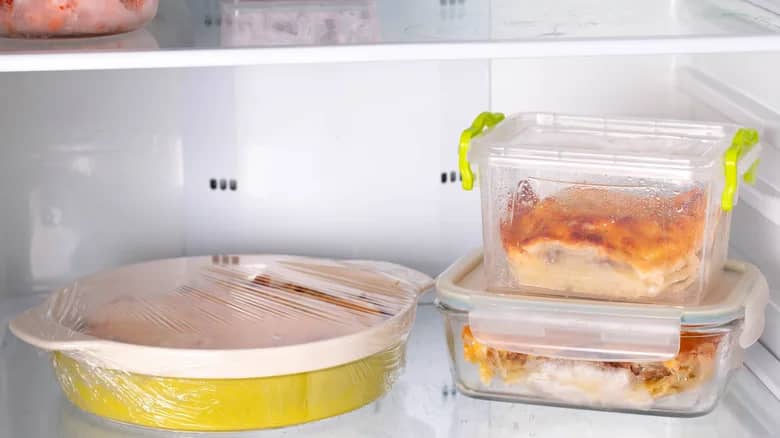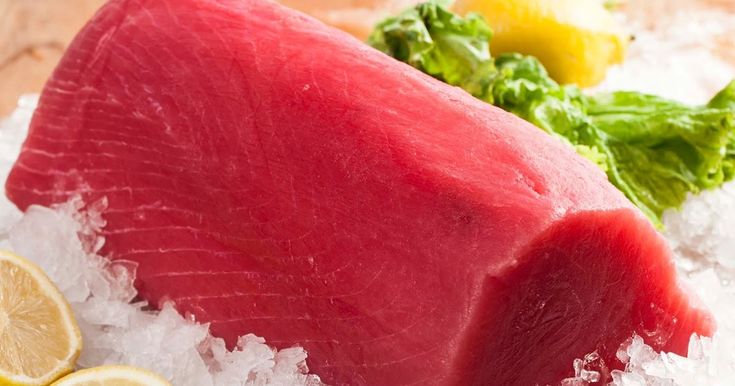Greetings! Today, I’m here to share my guide on storing raw tuna in the fridge. Whether you’re a sushi connoisseur or simply enjoy a fresh tuna salad, knowing how to properly store raw tuna is essential for maintaining its freshness and quality. So, let’s dive right in and discover the optimal storage period and techniques to keep your raw tuna fresh.
Key Takeaways:
- Raw tuna should be stored in the fridge at a temperature of 0—+5°C.
- Wrap raw tuna in foil, plastic wrap, or place it in a plastic container with a tight lid.
- Store raw tuna on the upper shelf next to a wall in the coldest part of the fridge.
- The optimal storage period for raw tuna is around 2 days, and it should not be consumed if stored for more than 3 days.
Why Storing Tuna in the Fridge is Important

When it comes to storing tuna, refrigeration plays a crucial role in maintaining its freshness and preventing bacterial growth. Storing raw tuna in the fridge helps to slow down the activity of microorganisms, ensuring that it remains safe for consumption.
To ensure optimal storage, it is recommended to set the fridge temperature between 0 and 2 degrees Celsius, although storing at temperatures up to 5 degrees Celsius is also acceptable.
However, it’s important to note that the standard fridge temperature of 5 degrees Celsius is not suitable for long-term storage of tuna. To maintain the best quality and extend the shelf life, the optimal temperature range for storing tuna is between -2 and 0 degrees Celsius. This lower temperature range helps to preserve the freshness of the fish and prevent spoilage.
By storing tuna in the fridge, you can enjoy fresh and safe fish for your meals. Remember to wrap the tuna in foil or use airtight plastic containers, placed on the top shelf near a wall, which is usually the coldest part of the fridge. Taking these simple steps will help keep your tuna fresh and delicious for longer periods of time.
The Importance of Refrigeration for Tuna Storage

Refrigeration is essential to slow down the spread of microorganisms and prevent bacterial growth in raw tuna. By keeping the tuna at the right temperature, you can ensure that it remains safe to eat and maintain its quality. When stored properly in the fridge, raw tuna can stay fresh for up to 2 days, allowing you to enjoy its flavors and benefits.
In summary, storing tuna in the fridge is important because it:
- Slows down the activity of microorganisms
- Prevents bacterial growth
- Extends the shelf life of raw tuna
So, the next time you have fresh tuna on hand, make sure to store it properly in the fridge to preserve its freshness and ensure a delicious dining experience.
| Benefits of Storing Tuna in the Fridge | Temperature Range |
|---|---|
| Slows down the activity of microorganisms | 0—2°C (up to 5°C acceptable) |
| Prevents bacterial growth | Optimal range: -2—0°C |
| Extends the shelf life of raw tuna | Do not exceed 3 days of storage |
Why Proper Storage Is Important for Fresh Tuna

Properly storing fresh tuna in the fridge is crucial to maintain its quality and prevent spoilage. Here’s why:
Storing fresh tuna in the fridge helps slow down the growth of bacteria and other microorganisms. By keeping the fish at a consistently cold temperature, you can extend its shelf life and ensure that it remains safe to eat.
Additionally, storing tuna in the coldest part of the fridge helps maintain its texture and flavor. The cold temperature helps preserve the natural freshness of the fish, allowing you to enjoy its rich taste and delicate texture for longer.
| Benefits of Proper Tuna Storage | Risks of Improper Tuna Storage |
|---|---|
| Extended shelf life | Quick spoilage |
| Maintained freshness | Loss of flavor |
| Reduced risk of foodborne illnesses | Increased bacterial growth |
By following proper storage techniques, you can maximize the freshness and quality of your fresh tuna, ensuring a delicious and safe dining experience.
Can Vacuum-Sealed Tuna Last Longer in the Fridge?
When it comes to prolonging the storage period of tuna, many people wonder if vacuum-sealed tuna can last longer in the fridge. The answer is yes, vacuum-sealed tuna can indeed extend its shelf life compared to other storage methods. Vacuum-sealing removes air from the packaging, creating an airtight environment that slows down the growth of bacteria and keeps the tuna fresh for a longer time.
Unopened vacuum-sealed tuna can last for two to three weeks in the fridge. It is important to store the vacuum-sealed tuna properly, placing it on the upper shelf next to a wall to ensure consistent temperature.
However, once the vacuum-sealed tuna is opened, it should be consumed within three days to maintain its freshness and flavor. It is recommended to consume it as quickly as possible after opening for the best taste and quality.
While vacuum-sealed tuna can prolong the storage period, it is worth noting that the freshness and quality of the tuna may deteriorate over time. Therefore, it is always best to consume the tuna within the recommended time frame for optimal taste and texture.
Freezing Fresh Tuna for Extended Storage

When it comes to prolonging the storage of fresh tuna, freezing is a great option. By following proper freezing methods, you can enjoy the delicious taste of tuna even after months. To begin, make sure to properly clean the tuna by gutting it, rinsing it under cold water, and patting it dry with paper towels. This will help remove any excess moisture and ensure the best quality when freezing.
After cleaning, it is recommended to cool the tuna in the fridge for 1-2 hours before freezing. This step helps to lower the temperature of the tuna and maintain its freshness during the freezing process. Once cooled, it’s time to divide the tuna into smaller pieces. Cutting the tuna into smaller portions not only makes it easier to use later but also helps with faster freezing and thawing.
When storing the tuna, wrap each piece in foil or place them in plastic containers with tight lids. This will protect the tuna from freezer burn and maintain its quality. It is crucial to set the freezer temperature between 0°C and -25°C to ensure optimal preservation. By keeping the tuna at these temperatures, you can safely store it for up to 6 months.
Note: If you have any problems with your freezer you can check here some of the most common problems.
Tips for Freezing Fresh Tuna:
- Clean the tuna thoroughly by removing its guts and rinsing it under cold water.
- Pat the tuna dry with paper towels to remove excess moisture.
- Cool the tuna in the fridge for 1-2 hours before freezing to maintain its freshness.
- Cut the tuna into smaller pieces for faster freezing and thawing.
- Wrap each piece in foil or place in plastic containers with tight lids to protect it from freezer burn.
- Set the freezer temperature between 0°C and -25°C for optimal preservation.
- Label the containers with the date of freezing to keep track of the storage period.
While freezing fresh tuna can extend its storage life, it is important to note that there might be some loss of texture and taste when thawed. However, when properly prepared and stored, frozen tuna can still be a fantastic ingredient for various recipes, including sushi, sashimi, or grilled dishes. So, go ahead, freeze your fresh tuna, and enjoy its deliciousness whenever you’re craving it.
I hope these tips on freezing fresh tuna help you prolong its storage and enjoy its flavors for months to come. With proper cleaning, portioning, and storage, you can have a freezer stocked with high-quality tuna ready for your culinary creations whenever you need them.
| Freezing Fresh Tuna Tips | |
|---|---|
| 1. Clean the tuna thoroughly by removing its guts and rinsing it under cold water. | |
| 2. Pat the tuna dry with paper towels to remove excess moisture. | |
| 3. Cool the tuna in the fridge for 1-2 hours before freezing to maintain its freshness. | |
| 4. Cut the tuna into smaller pieces for faster freezing and thawing. | |
| 5. Wrap each piece in foil or place in plastic containers with tight lids to protect it from freezer burn. | |
| 6. Set the freezer temperature between 0°C and -25°C for optimal preservation. | |
| 7. Label the containers with the date of freezing to keep track of the storage period. |
Conclusion

In conclusion, proper storage of raw tuna is essential to maintain its freshness and quality. By following the guidelines outlined in this article, you can ensure that your raw tuna stays safe to consume and delicious for your culinary creations.
Storing raw tuna in the refrigerator at a temperature range of 0—+5°C, wrapping it in foil or plastic wrap, and placing it on a bed of ice can help extend its shelf life. It is recommended to consume raw tuna within 2 days of storage in the fridge and not exceed a maximum storage period of 3 days.
Vacuum-sealed tuna can last longer in the fridge, but it is important to consume it within three days of opening. If you need to store fresh tuna for an extended period of time, freezing can be an option. However, keep in mind that there may be some loss of texture and taste when thawed.
By following these simple tips, you can ensure that your raw tuna remains fresh, safe, and ready to be transformed into delicious dishes.
FAQ
How long can raw tuna be stored in the fridge?
Raw tuna can be stored in the fridge for up to 2 days.
What is the recommended temperature for storing raw tuna in the fridge?
Raw tuna should be stored at a temperature range of 0—+5°C.
How should I wrap raw tuna for storage in the fridge?
Raw tuna can be wrapped in foil, plastic wrap, or placed in a plastic container with a tight lid.
Where in the fridge should I store raw tuna?
It is recommended to store raw tuna on the upper shelf next to a wall in the coldest part of the fridge.
Can I add ice to the container to extend the freshness of raw tuna?
Yes, adding ice to the container can help extend the freshness of raw tuna.
What is the optimal storage period for raw tuna in the fridge?
The optimal storage period for raw tuna in the fridge is around 2 days.
Can I consume raw tuna that has been stored for more than 3 days?
It is not recommended to consume raw tuna that has been stored for more than 3 days.
How long can unopened vacuum-sealed tuna last in the fridge?
Unopened vacuum-sealed tuna can last for two to three weeks in the fridge.
How long can opened vacuum-sealed tuna last in the fridge?
Opened vacuum-sealed tuna should be consumed within three days.
How should I store fresh tuna in the fridge?
Fresh tuna should be wrapped in foil or placed in a plastic container with a tight lid. It should be stored on the upper shelf next to a wall in the coldest part of the fridge.
How long can fresh tuna be stored in the fridge?
Fresh tuna can be stored in the fridge for up to 2 days.
Can fresh tuna be frozen for extended storage?
Yes, fresh tuna can be frozen for extended storage.
How long can frozen tuna be stored?
Frozen tuna can be safely stored for up to 6 months.
What should I do before freezing fresh tuna?
Before freezing fresh tuna, it should be gutted, rinsed under cold water, and dried with paper towels.
What temperature range should be maintained when freezing tuna?
The temperature range should be maintained at 0°C to -25°C when freezing tuna.
Will freezing affect the texture and taste of tuna?
Yes, there may be some loss of texture and taste when thawing frozen tuna.
How can I keep tuna fresh in the fridge?
To keep tuna fresh in the fridge, rinse it under cold water, remove guts and gills, and wipe it dry with paper towels. Wrap the tuna in foil or place it in a plastic container with a tight lid. Keeping the tuna on a bed of ice in the fridge can further extend its freshness.

